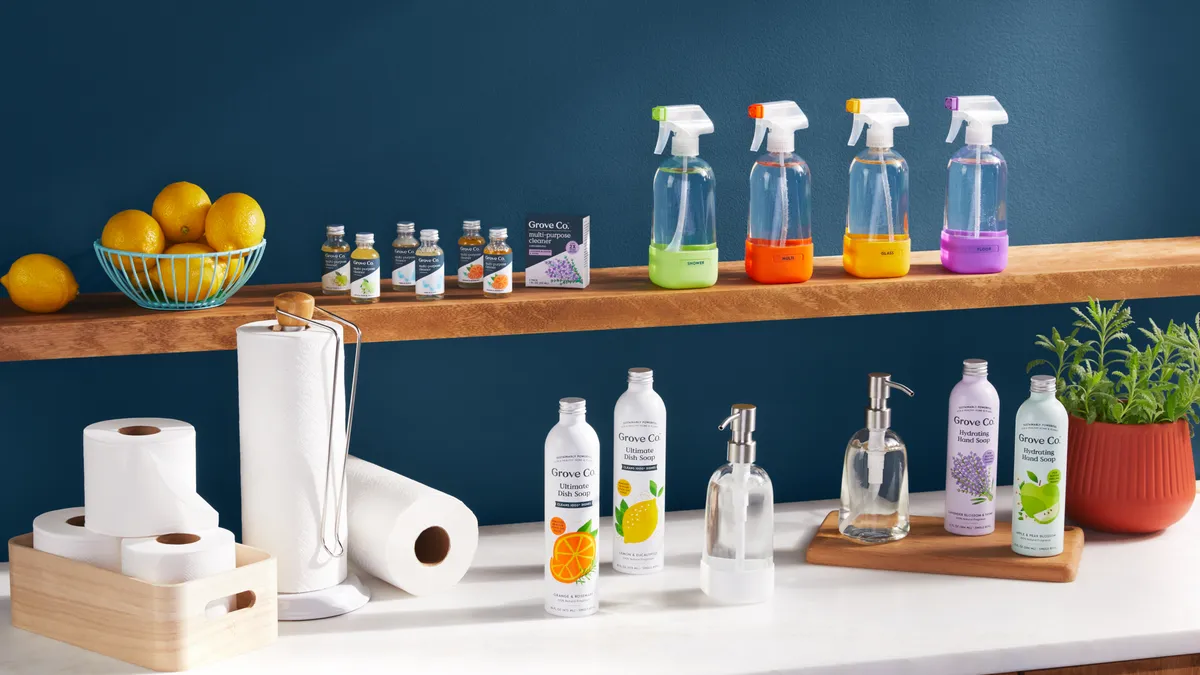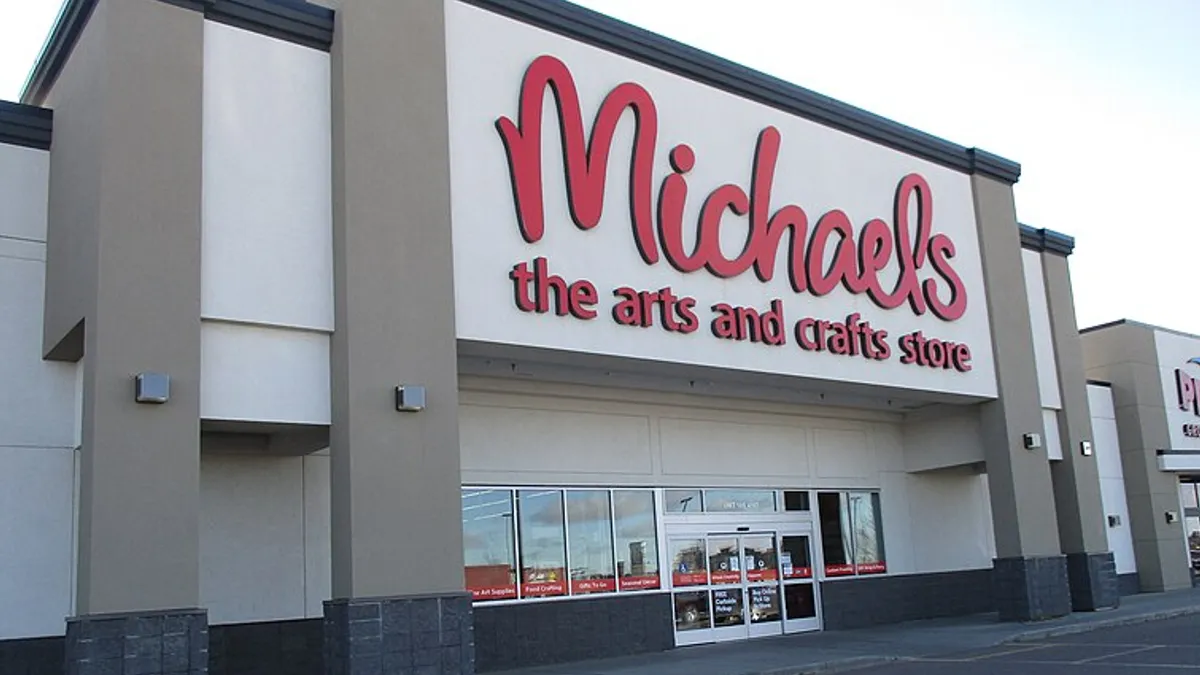Spring cleaning has a different meaning for Grove Collaborative. The company is embarking on several changes to boost both its bottom line and planet-friendly reputation.
Earlier this month, the company rebranded its core private label, Grove Co., to improve visibility on retail shelves. Grove also consolidated all of its own brands under the Grove Co. label.
The sustainability-driven home products company also launched a new e-commerce model in late February to encourage noncore customers to browse freely on the company’s website and incentivize them to order more products.
“We will move from the gated first order experience to one that is shopping focused and provides incentives for customers to subscribe to items and build the most planet-friendly and wallet-friendly order as possible," CEO Jeff Yurcisin said, according to a transcript of the company’s fourth-quarter earnings call on March 6. “We expect this to reactivate and reenergize our 5 million customer base, further increase our total addressable market and appeal to all conscientious customers."
Change is necessary to stay afloat financially, Yurcisin said. Net revenue in the fourth quarter was $59.9 million, down 3.1% from the third quarter of 2023 and 19.2% year over year. For the year ahead, the company expects net revenue between $215 million to $225 million and adjusted EBITDA margin of 0% to 1%.
“This is just the reality of what happens in a subscription model – when you go from unsustainable advertising spend to growing more organically from your core, and then growing out in a more candidly sustainable way,” Yurcisin said in a recent interview with Retail Dive. “These changes will allow us to better match best practices across e-commerce that I've seen throughout my career and drive growth in new acquisition channels.”
Under the former subscription model, customers were onboarded with a default subscription. While they received freebie gifts to entice them to try Grove’s products, they had to subscribe to repeat orders for any product they purchased themselves.
“We just blew up that model … and [are] enabling a wider set of customers to open up the [total accessible market],” Yurcisin said. “Now you can just purchase [an item] and we can be that trusted brand for you. Secondly, we’ll be able to better find those customers using more traditional channels, like Google.”
The revamped subscription model debuted on Feb. 29, and Yurcisin said the initial response has been positive. Yurcisin said vendors are helping to fund some of the subscribe-and-save benefits through a partnership with Grove. Over half of the products found on the website are available for subscribe-and-save.
“It’s the inactive customers that I believe we really have a path to really engage because they like us,” Yurcisin said. “When we surveyed them, they still trust us and are still Grove fans. They just haven’t had a need for a box showing up in a particular type of subscription model on a very regular basis. So we’re approaching this a little differently.”
New customers will get 20% off their first order with Grove when they subscribe to an individual product, then 5% off each subscribed item in repeat orders thereafter.
“Now we have an incentive … through subscribe-and-save — by partnering with our vendors to lock in these wonderful dark green customers,” Yurcisin said, referring to environmentally conscious shoppers. “The people who want to change daily life to be a little bit more planet first.”
But Yurcisin acknowledged that attracting this group and staying profitable is a balancing act.
“Each e-commerce retailer needs to find their own unique business model that allows them to serve customers well, but also deliver enough margins to have a sustainable, profitable business," Yurcisin said in an email to Retail Dive. "Grove is the first retailer to be plastic neutral with carbon neutral shipments. Our customer chooses us because we help them find those great products that minimize their impact on the environment.”
But when many items on Grove’s site are under $10, getting to bigger orders requires subscriptions, according to Yurcisin.
“What we have to do is get to a large enough order size with $50, $60, $70, $80 in a box, where we are able to ship to a customer in a planet friendly way,” Yurcisin said. “The customer receives real value, the shipping cost per item decreases, and the impact we have on the planet improves — mainly because our unique offering is the only one that is most focused on reducing, measuring, and reporting one’s plastic pollution impact.”
‘I think we have home position right now’
Last fall, Grove Collaborative announced a leadership shake-up with co-founder Stuart Landesberg stepping down as CEO after a decade. Landesberg became executive chairman on the company’s board, and he continues to oversee strategy, capital markets and corporate development. Yurcisin officially took over the CEO role last August.
Eight months in, Yurcisin wants the company to reach profitability and prioritize innovation, while staying true to its planet-first mission.
“Our vision is to truly transform the consumer products industry into a force of human and environmental good,” Yurcisin said.
The San Francisco-based eco-friendly products company is doubling down on sustainability. Yurcisin refers to this as “Grove’s point of differentiation” and why customers trust the brand.
“There is a wonderful tailwind and all the trends are behind it. It’s mission driven, and if you look at younger customers, they’re the ones who value transparency in the ingredients you’re putting in, and customers who just care about sustainability,” added Yurcisin. “All of these are tailwinds that will intersect.”
Yurcisin, a veteran of Shopbop, Zulily and Amazon, said he chose Grove because he wanted his next opportunity to have a positive impact on the world. He liked Grove Collaborative’s mission-driven mandate of reducing plastic use and waste with more sustainable, lower plastic footprint products.
Grove produces soap pods that can be thrown into a dishwasher and laundry detergent sheets, among its product offerings. Yurcisin said he’s listening to Grove’s core customers as it expands into new categories.
Grove Collaborative has sold health and wellness products on its marketplace since 2020, according to the company. The expanded focus on categories like vitamins, minerals and supplements began in March 2023 with Grove Wellness. The online hub offers customers a curated assortment of health and wellness products.
“Where I want to take us is to be the trusted brand for conscientious customers,” Yurcisin said of the firm’s expansion from the sustainable cleaning space to health and wellness.
According to survey data the company cited last year, 75% of its customers currently buy wellness products, and 89% said they trust Grove more than other brands to provide those products.
“That is truly the tip of the spear when it comes to innovation — having products that are both efficacious [and] high performing, but also planet first,” Yurcisin said. “It can’t just be a planet-first product,” he added. “It has to be high performing and just as good as some of the alternatives.”
Yurcisin is also plastic obsessed. Or, rather, he’s reducing-plastic obsessed.
Since 2020, the company has collected some 15 million pounds of single-use nature and ocean bound plastics through its partnership with plastic recovery platforms. For every ounce of plastic shipped to Grove customers, the company collects the equivalent amount of plastic through its ongoing partnership with rePurpose Global, according to the company.
“I see single-use plastic as the enemy. We put all of this plastic into our recycling bin and only 5% of it gets recycled. Some of it ends up in a landfill, but a lot of it ends up in the ocean, burned or shipped overseas,” Yurcisin said. “We’re the only retailer I know that measures plastic in grams and ounces of our products. We track it, measure it, and report about it in our quarterly earnings, all in an effort to earn customers’ trust.”
Grove translates all of this plastic data into a three-tier badge system, which is part of the company's Beyond Plastic initiative. The tier system helps customers make informed purchasing decisions based on plastic. Customers can look for three badges on products on the website, including 100% plastic-free, 95%-plus plastic free and no single-use plastic.
“There are more customers who care about reducing their plastic waste and plastic footprint than they do [about] global warming,”Yurcisin said. “We are that leader saying, ‘Let’s help you. Where are you on your journey, and how can we help you reduce single-use plastic?’”
There is booming interest among customers in sustainability, according to Yurcisin. But that interest may be waning. Consumers in the U.S. are less sustainably minded compared to a year ago, according to a Global Voices survey from ESW released in April.
“I think there’s going to be a billion-dollar retailer out there one day, a billion-dollar brand, that consistently earns customers’ trust in their transparency and helps consumers find the right type of product,” Yurcisin said.
He added that he wants to lead Grove to become that eco-friendly, billion-dollar retailer.
“I think we have home position right now,” Yurcisin said. “We’re probably the leader there … but we have a lot of work to do.”
Although the company’s revenue is declining, Grove Collaborative reached a new high in DTC net revenue per order of $66.83 in Q4, something Yurcisin is proud of, as he turns his attention to improving DTC.
Yurcisin said wholesale also performed “incredibly well” in Q4, and that consumers can expect to see new product offerings hitting the shelves at the end of Q1 or early Q2.
“They asked me to come in and lead the company, so let’s make sure we’re profitable and growing and still leaning on sustainability and helping customers make right decisions,” Yurcisin said.
Correction: A previous version of this article misstated the discount applied to customers' first subscription order and misclassified the badges within its "Beyond Plastic" initiative. This story has been updated to better reflect the discount provided, as well as more accurately define the Beyond Plastic initiative.




















